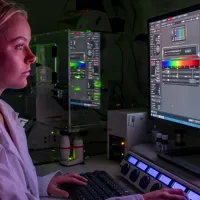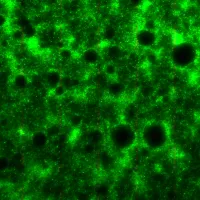During the coronavirus (COVID-19) pandemic, thousands of critically ill patients were ventilated to keep them alive. But intubation always comes with risks and many developed dangerous bacterial infections such as pneumonia that were tricky to treat.
Now researchers at the University of Southampton are refining a technology that could identify the bacteria causing these infections in a matter of minutes, that could enable targeted, rapid treatment and so save lives.
For some bacterial illnesses, identifying which strain is infecting a patient is crucial to doctors treating it successfully. Many bacteria are now resistant to multiple antibiotics, and through a microscope they can all look very similar, indistinguishable by shape, size or colour.
At Southampton, Research Fellows Dr Niall Hanrahan, an expert in spectroscopy, and Dr Callum Highmore, an expert in microbiology, are working on new ways to differentiate between bacterial strains using the power of lasers. “Everyone has heard of MRSA, right? It’s a killer threat. Trying to distinguish that from non-methicillin-resistant Staphylococcus aureus isn’t really possible using a simple microscope,” Niall explains.
When a green or red laser is directed at a target, the way the molecules vibrate in response depends on their make-up. Spectroscopy experts can interpret the signals that they get back from those vibrations – known as the ‘Raman spectrum’ – to produce an “optical fingerprint”. These “fingerprints” can then be used to work out exactly which strain is being examined in minutes.
A patient suffering from a bacterial infection may not have a few days. They may only have a few hours.
Dr Niall Hanrahan
Once doctors have that information they can prescribe the right medication to tackle it, rather than rely on broad spectrum antibiotics. While these work against numerous types of bacteria, they are becoming less effective owing to their widespread use.
Trials have been extremely successful and are continuing. There is huge commercial potential for the technology, and Niall and his team are working with, and seeking new, investors.
Once commercially viable, the technique could save the health service thousands of clinical hours and help doctors prescribe effective, targeted treatments to the most critically ill patients in record time. It could also free up NHS bed capacity, reduce pressure on intensive care units and help tackle antibiotic resistance.
And the potential doesn’t end there. Trials have also begun for use of this spectroscopy technique in other applications, including in water treatment, legionella detection and neurodiagnostics.
Niall, who started his career as a chemist, says he’s in this for the long haul. His career ambition is to find other, equally beneficial ways to use these optical technologies to tackle the biggest problems in human healthcare. “It’s a great space to be in. It’s got the right philosophy behind it: making things better for people,” he says.
I really want to see it through. It’s very personally rewarding that we can work towards solving real problems with such simple methods
Dr Niall Hanrahan





